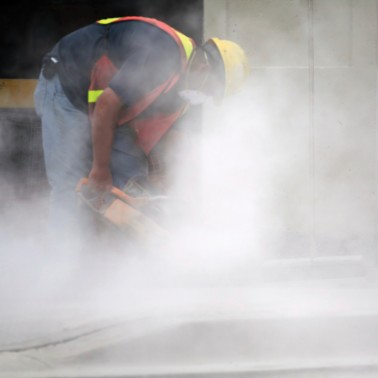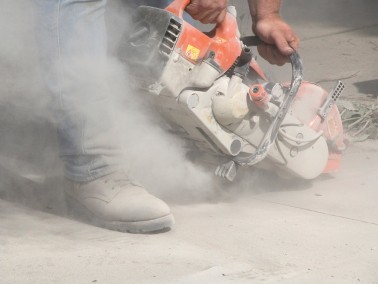Risk assessing general workplace dusts
 Airborne dusts are of particular concern as they are associated with widespread occupational lung diseases. The health effects are not only caused by exposure to toxic dusts, such as asbestos, wood dust and crystalline silica, but also by exposure to general workplace dusts — poorly soluble, low-toxicity, non-fibrous dusts.
Airborne dusts are of particular concern as they are associated with widespread occupational lung diseases. The health effects are not only caused by exposure to toxic dusts, such as asbestos, wood dust and crystalline silica, but also by exposure to general workplace dusts — poorly soluble, low-toxicity, non-fibrous dusts.
Dusts
Dusts are airborne solid particles ranging in size from below 1μm (one thousandth of a mm) up to around 100μm (0.1mm). The airborne particles are generated by man-made processes, such as crushing, grinding, bagging and sweeping, and also by natural forces, such as wind and volcanic eruption. Once airborne, the dust particles settle slowly under the influence of gravity.
The effect that general workplace dust has upon the lungs depends upon the size and other physical characteristics of the particles. From an occupational health point of view, dust is classified into:
- inhalable dust — larger-sized particles, most of which will be filtered out in the nose and throat
- thoracic dust — smaller-sized dust particles that can reach the lungs
- respirable dust — dust that is small enough to be inhaled deeply, and can penetrate beyond the terminal bronchioles into the gas-exchange region of the lungs.
General workplace dusts
General workplace dusts include coal dust, talc, kaolin, polyvinyl chloride (PVC) and mixtures containing amorphous silica, silicon, silicon carbide, pulverized fuel ash, limestone, gypsum, graphite, aluminium oxide, titanium dioxide, other mineral dusts with low crystalline silica content, and organic dusts free of harmful bacteria or biological toxins such as endotoxin — unless they are considered to be hazardous because of their biological component. Soluble dusts are excluded from this definition because of their short residence time in the lung.
COSHH and general workplace dust
The Control of Substances Hazardous to Health Regulations 2002 (COSHH) definition of a substance hazardous to health includes dust that is not a substance classified under the Chemicals (Hazard Information and Packaging for Supply) Regulations 2009 (CHIP 2009) as very toxic, toxic, harmful, corrosive or irritant, or has a Workplace Exposure Limit (WEL), or is a biological agent, or is a substance hazardous to health under COSHH if it is present at a concentration in air equal to or greater than:
- 10mg/m3, as a time-weighted average over an eight-hour period, of inhalable dust
- 4mg/m3, as a time-weighted average over an eight-hour period, of respirable dust.
The requirements of COSHH — the need to assess the risk to workers and to ensure exposure is prevented or adequately controlled — apply when these concentrations of dust in air are exceeded. However, these levels, which were taken from figures developed more than 50 years ago by the American Conference of Government Industrial Hygienists, were based on expert opinion, rather than any health-based criteria. Consequently, it is important to recognise that these concentrations are not Occupational Exposure Limits or WELs, but are the levels at which the COSHH regulations come into effect.
There have been calls for a dramatic reduction in the levels of inert dusts, at which COSHH comes into effect, from the Trades Union Congress (TUC) and the IOM. The TUC claims that there is now clear scientific evidence that suggests that the current UK limits for inhalable and respirable dust should be much lower. The TUC claims that the research shows that, for some dusts, even a 1mg/m3 limit would not be protective. The IOM considers that the current British occupational exposure limits for airborne dust are unsafe, and employers should attempt to reduce exposures to help prevent further cases of respiratory disease among their workers. The IOM recommends that employers should aim to keep exposure to respirable inert dust below 1mg/m3 and inhalable inert dust below 5mg/m3.
The assessment: inhalation
 The assessment of the risks from dust will depend on the nature of the dust. If the dust is classified as very toxic, toxic, harmful, corrosive or irritant, or has a WEL or is a biological agent or a substance hazardous to health, the requirements of COSHH will apply. This will involve assessment of the risk to health created by work involving the dust; prevention or control of exposure to the dust; maintenance, examination and testing of any control measures used; monitoring exposure at the workplace; information, instruction and training for persons who may be exposed to the dust; and, in some cases, health surveillance.
The assessment of the risks from dust will depend on the nature of the dust. If the dust is classified as very toxic, toxic, harmful, corrosive or irritant, or has a WEL or is a biological agent or a substance hazardous to health, the requirements of COSHH will apply. This will involve assessment of the risk to health created by work involving the dust; prevention or control of exposure to the dust; maintenance, examination and testing of any control measures used; monitoring exposure at the workplace; information, instruction and training for persons who may be exposed to the dust; and, in some cases, health surveillance.
There may be dusts without a formal WEL. For these dusts, employers need to consider setting in-house standards limits lower than the low-toxicity 10mg/m3 inhalable dust or 4mg/m3 respirable dust limits. Dusts not in these categories become substances hazardous to health under COSHH if their concentrations in the air, as a time-weighted average over an eight-hour period, is equal to or greater than 10mg/m3 inhalable dust or 4mg/m3 respirable dust. Where tasks may generate high levels of dust, a dust survey to assess dust levels in the workplace should be carried out. This may involve measurement of the levels of dust in the air, both by static monitoring as well as personal monitoring. The determination of levels of respirable dust and inhalable dust should be undertaken using the methods described in MDHS14/3: General Methods for Sampling and Gravimetric Analysis of Respirable and Inhalable Dust. The determination involves drawing a measured volume of air through a collection substrate, such as a filter mounted in a sampler, and determining the mass of dust collected by weighing the substrate before and after sampling. The respirable fraction is generally collected using a cyclone pre-selector.
Control of exposure
In order of preference, the hierarchy of measures to be applied to preventing or controlling the risks from inhaling dusts, include:
- elimination — preventing the formation of dust by using special cutting techniques rather than by grinding or sawing, or by using wet-cutting processes
- substitution — using dust-suppressed materials and emulsions or pastes rather than mixing dry constituents
- containment — the physical enclosure of dust-producing processes under negative air pressure (slight vacuum compared to the air pressure outside the enclosure)
- controlling the extent of the exposure, for example, through a safe system of work, or by partial enclosure and extraction equipment and procedural controls, such as reducing the number of people exposed, and frequency and duration of exposure
- using respiratory protective equipment (RPE) — providing RPE in addition to other measures, only where adequate control of exposure cannot be achieved by the other means.
It is essential that workers, through education, understand the need to avoid the risks from general workplace dusts. The assessment of the level of control required should take into account vulnerable employees. People with heart or lung disease, and older adults who carry out work that involves physical activity, are considered at greater risk from general workplace dusts. Physical activity causes the individual to breathe faster and more deeply, and consequently to take more particles into his or her lungs.
Control to a lower level?
Employers may want to consider whether controlling exposure to general workplace dust to below the levels at which they become substances hazardous to health under COSHH is sufficient, or whether they should consider exposure to lower levels, such as the levels recommended by the IOM — inhalable dust below 5mg/m3 and respirable dust below 1mg/m3.
Take a look at our step-by-step guide on how to carry out a COSHH Assessment.
